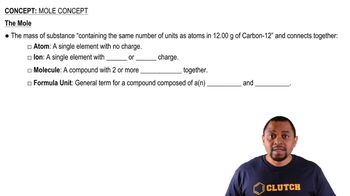The following diagrams represent a hypothetical reaction A ¡ B, with A represented by red spheres and B represented by blue spheres. The sequence from left to right represents the system as time passes. Does the system reach equilibrium? If so, in which diagram(s) is the system in equilibrium? [Sections 15.1 and 15.2]
Ch.15 - Chemical Equilibrium
Chapter 15, Problem 4d
The following diagram represents a reaction shown going to completion. Each molecule in the diagram represents 0.1 mol, and the volume of the box is 1.0 L. (d) Assuming that all of the molecules are in the gas phase, calculate n, the change in the number of gas molecules that accompanies the reaction. [Section 15.2]
 Verified step by step guidance
Verified step by step guidance1
Identify the number of gas molecules before and after the reaction by counting the number of molecules represented in the diagram for each state.
Calculate the initial number of moles of gas molecules (n_initial) by multiplying the number of molecules before the reaction by 0.1 mol, as each molecule represents 0.1 mol.
Calculate the final number of moles of gas molecules (n_final) by multiplying the number of molecules after the reaction by 0.1 mol.
Determine the change in the number of moles of gas molecules (\(\Delta n\)) by subtracting the initial number of moles from the final number of moles, i.e., \(\Delta n = n_{final} - n_{initial}\).
Interpret the result: if \(\Delta n\) is positive, the reaction results in a net increase in the number of gas molecules; if negative, there is a net decrease.

Verified video answer for a similar problem:
This video solution was recommended by our tutors as helpful for the problem above.
Video duration:
5mWas this helpful?
Key Concepts
Here are the essential concepts you must grasp in order to answer the question correctly.
Mole Concept
The mole is a fundamental unit in chemistry that quantifies the amount of substance. One mole corresponds to approximately 6.022 x 10^23 entities, such as atoms or molecules. In this context, understanding the mole allows us to relate the number of molecules in the reaction to the amount of substance, which is crucial for calculating changes in the number of gas molecules.
Recommended video:
Guided course

Mole Concept
Ideal Gas Law
The Ideal Gas Law (PV=nRT) describes the relationship between pressure (P), volume (V), temperature (T), and the number of moles (n) of a gas. This law is essential for understanding gas behavior under various conditions. In this question, it helps in determining how the number of gas molecules changes as the reaction proceeds, especially since the reaction is occurring in a fixed volume.
Recommended video:
Guided course

Ideal Gas Law Formula
Stoichiometry
Stoichiometry involves the calculation of reactants and products in chemical reactions based on balanced equations. It allows chemists to predict the quantities of substances consumed and produced. In this scenario, stoichiometry is vital for determining the change in the number of gas molecules, as it provides the ratios needed to relate the initial and final amounts of reactants and products.
Recommended video:
Guided course

Stoichiometry Concept
Related Practice
Textbook Question
1
views
Textbook Question
Ethene (C2H4) reacts with halogens (X2) by the following reaction:
C2H4(𝑔) + X2(𝑔) ⇌ C2H4X2(𝑔)
The following figures represent the concentrations at equilibrium at the same temperature when X2 is Cl2 (green), Br2 (brown), and I2 (purple). List the equilibria from smallest to largest equilibrium constant. [Section 15.3]
Textbook Question
When lead(IV) oxide is heated above 300°C, it decomposes according to the reaction, 2 PbO2(𝑠) ⇌ 2PbO(𝑠) + O2(𝑔). Consider the two sealed vessels of PbO2 shown here. If both vessels are heated to 400°C and allowed to come to equilibrium, which of the following statements is or are true? a. There will be less PbO2 remaining in vessel A,
